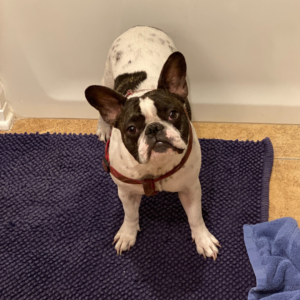How to save a ton of money on pet costs
Unprepared for the expenses of two dogs? Our ultimate guide to pet costs will help you save money.
Our pet cost from adopting Luca & Loki
One of our dreams for the longest time, nearly 10 years, was to get French Bulldogs.
We didn’t want just one. We wanted three. One would be a girl named Luca, inspired by the Last Universal Common Ancestor, and a boy named Loki, inspired by the mischievous Nordic god. The third would be an older Frenchie, possibly one with special needs, that we’d adopt and name Lucky.
But then we became liberated, living and traveling all over the world (throughout the U.S., Spain, and France), and buying and adopting dogs made zero sense. And then the pandemic happened, and we found ourselves living in Vegas (a whole other Oprah). About nine months or so after living in Vegas and dealing with the desert heat and COVID, meaning never really leaving our apartment, we decided it was time to get dogs, and we decided to adopt Lucky first.
So, we applied to both the Nevada Frenchie Rescue and the Rocky Mountain French Bulldog Rescue. Our roots are in Denver, and driving there to pick up a dog would give us an excuse to visit friends and family. For financial preparation and manifestation, we started to set aside money each month to cover adoption fees and other initial new pet costs.
A couple of months went by, and we came close to one adoption. But the original owner decided not to relinquish it. Another few months went by, and the Nevada Frenchie Rescue let us know we were next in line for another adoption. They had two dogs who needed to be rehomed, but there was a contingency.
The owner wanted them to be adopted together, as they were two-year-old siblings (from the same litter) who had been together their whole lives. They were perfectly healthy. There was no abuse or neglect; the owner was simply allergic to them and couldn’t find a solution to keep them around for the two or so years she owned them.
Suddenly, we were adopting Luca and Loki! Were we ready for this? Did we want to miss a great opportunity?
Yes and no.
After a couple of very long weeks, on a Saturday, the rescue delivered our new French Bulldogs. Luca and Loki were home.
And we’ve been happy ever since . . . well, except for the expenses.
As we shared, we were setting aside money every month in preparation for their arrival. By the time they arrived, we had saved about $2,500. But that wasn’t enough—not nearly enough.
What follows is what we’ve learned with Luca and Loki on how to save money on pet costs.
How much are adoption costs?
In our quest to buy or adopt dogs, we found a range of costs. Getting a new puppy or kitten will usually cost you, and the price is dependent on the breed of dog or cat you purchase. Of course, getting some kittens or cats for free can be pretty straightforward.
Places that take in and offer adoptions for lost or relinquished pets often ask for a simple, nominal donation. This covers the costs of running the facility, and, unfortunately, more and more pets are being relinquished as people return to work after the pandemic. The suggested minimum donations range between $25 – $75.
Of course, you can always give more. If you do give, see if your employer offers a corporate match for your donations. In some cases, employers will match donations dollar-for-dollar up to a certain point.

Your pet’s cost to purchase a new puppy could be as high as $14,000 or more for Samoyeds, Lowchews, and Chow Chows. The average cost for a new puppy in the U.S. is between $400 and $2,000. For new kittens, your pet’s cost could be as high as $125,000 for Asheras or $20,000 for Savannahs. The average cost for a new kitten in the U.S. is between $0 and $400.
Pet costs for adoptions, however, are a different story and are all over the board. There are a lot of variables that go into calculating the cost of adopting a rescue. Most rescues are non-profits but still have overhead costs. The rescue pet’s condition, unfortunately, can sometimes be dire if they’ve been abused or neglected. Most rescue centers can’t afford to absorb these costs and must transfer these expenses to the new adopting owner. All that said, adoption fees average between $50 to $350 but can go way higher.
We adopted two two-year-old, healthy French Bulldogs. As we shared, ours was more of an adoption and less of a rescue. Our total pet cost for both Luca and Loki was $1,500.
The best way to keep this pet cost down, though, is to adopt your pet from the pound or rescue. There are way more cats and dogs than there are loving homes for cats and dogs. Keep your pet costs down and give a needy pet a loving home (then make sure they’re spayed or neutered).
You’ll likely ask yourself someday, “Who rescued who?
How much are initial pet costs?
Purchase or adoption fees won’t be your only initial expense, especially if this is your first pet. You can expect to pay between $500 and $1,000 on total initial pet costs, depending on whether you get a cat or a dog and the condition of your new cat or dog.
Below is a list of initial pet costs.
1. Adoption and purchase costs
As we just covered, adoption fees for your new kitten, puppy, cat, or dog can range from $0 to $125,000, with the average cost between $50 and $350. The best way to keep these pet costs down is to adopt a pet from a pound, shelter, or rescue.
2. Food and water bowls
Fido and Fluffy must eat. The average costs of food and water bowls for dogs and cats range between $10 to $50. You can, however, find bowls on Chewy.com for under $1. Another way to keep pet costs down and help reduce waste is to buy your pet bowls from a thrift shop.
We bought two simple stainless steel food bowls (15 ounces each) for Loki, our boy dog, at $13 each. We also got two larger (28-ounce) stainless steel water bowls for Luca and Loki at $14 each.
Luca, however, eats as fast as we do on Thanksgiving Day after running a Turkey Trot. This upsets her stomach and makes her vomit. So, we bought her two slow-feeder bowls at $9 each.
She steps up to the challenge twice a day and still eats nearly as fast as her brother.
3. Initial medical exam
Whether you have a new puppy or kitty or adopted an older dog or cat, you’ll want to get them an initial medical exam or a simple checkup without additional care. The average pet cost for an initial exam ranges between $70 and $100 but can be as low as $50 and as high as $500. Our initial medical exam costs for Luca and Loki were $48.95 each.
Services around the country offer free or low-cost pet care for those struggling financially, senior citizens, and homeless people. Visit humansociety.org if this includes you or someone you know.
That’s one way to keep this pet cost down. Another way is to purchase pet insurance.
Buying pet insurance is a great way to ensure your pet gets all the medical care they need and control the costs. French Bulldogs are known to need regular medical attention that can average over $1,000 per dog a year. Our vet says that French Bulldogs were bred to drain your wallet, and so far Luca and Loki are living up to the cliché.
That’s one reason we got pet insurance through Lemonade. Another is that we didn’t want to ever question whether we could afford to give Luca and Loki the medical care they needed.
4. Collar, leash, or harness, and tag
Some collars for dogs and cats cost less than $5, and some push $100. Leashes can be under $5 or more than $80. The average cost for a collar or harness and leash combo ranges between $15 and $60.
We bought Luca and Loki a $11.50 harness and leash combo. Six months later, we’re in the market for new harnesses.
About twice a day, Luca and Loki play like Nala and Simba in The Lion King. Even though it’s clearly a holding penalty, they both latch onto the other’s harnesses with their teeth to drag the other down. Now, their harnesses are shredded and compromised.
We’re now looking to buy nylon harnesses and leashes (we like them matching because fashion matters). These harnesses and leashes are $39 each.
Your best bet for keeping this pet cost down is to get your collar, leash, or harness at a thrift shop. Be careful that whatever you buy isn’t compromised. Pets can act erratic, and you don’t want your pet breaking loose and running into danger.
Pet tags cost between $7 and $20, depending on how fancy you want them. Because tags are engraved, they’re hard to find at thrift shops unless you want to buy your tag first and then get your pet. The best way to keep this cost down is not getting a tag for your pet. After researching dog tags for Luca and Loki, we opted out of getting tags ourselves.
There have been a slew of French Bulldogs stolen from their owners lately, with the theft of Lady Gaga’s dogs making headlines. We read that tags make it easier for would-be thieves to steal your pet because they give these cruel strangers your pet’s name, which can make it appear as though your pet’s familiar with these ne’er-do-wells.
5. Bed and crate
When we were kids, our family dogs and cats didn’t have beds and crates. But we also didn’t wear seatbelts in cars, and drivers smoked cigarettes with the windows up. This is the 21st century.
Dogs and cats require beds and crates today.
Dog and cat beds run as low as $10 and over $150—the average ranges between $30 and $40. If you get a bed, you’ll need one that’s conducive to the size of your pet. So, the $10 option won’t suit all pets, and a $150 bed is unnecessarily large for a Chihuahua.
The cost of a crate, like that of a bed, depends on the size of your pet. Crates cost as little as $30 and more than $200. We bought two 24” collapsible fold-and-carry crates for $33 each. One is pink, and one is blue. They’re the perfect size for our 26-—and 28-pound dogs.
We haven’t assigned them a colored crate based on their gender because that’s stupid. They go back and forth as they like. We just wanted something more interesting than the standard black wire crates.
Again, the best way to keep these costs down is to thrift shop, either at thrift stores, garage sales, or flea markets, or take an unused bed or crate from a friend or acquaintance with their permission, of course.
There are also instructions all over the interweb for DIYing pet beds for less than $25.
6. Travel carriers
You’ll undoubtedly want to travel with your pet, as we do. They’re our kids. With that, you’ll want a carrying crate.
There are a wide variety of travel carriers from which to choose. They are complex and soft, carry and roll, small and large. The smaller your pet, the more options you have and the cheaper your options are.
Pushing 30 pounds, our dogs are somewhat limited in options. If they were any more significant, taking them on a plane with us wouldn’t be an option at all. We’d have to put them in cargo (which would break our hearts).
There are cat carriers for less than $20 and dog carriers for up to $170. The average for carriers is $60. We’re looking to buy 4-in-1 travel carriers that include rollers, backpacks, carry, and car seat options, and they cost $139. They’ll cost us $278 total.
Leaving your dog or cat at home when you travel may seem like a cheaper option, but pet sitters and boarding are often expensive. Leaving cats at home is a little easier if they’re trained to use a litter box and you have an automatic feeder. Some automatic feeders can dispense food for up to three days.
The cheapest option we’ve used is a membership website, TrustedHousesitters.com. The current cheapest membership fee is $130/year. Trusted House Sitters connects people with pets with people who like pets and are willing to travel nearly anywhere to pet sit at no expense to the pet owner. This is easier for pet owners who live in travel destinations, such as Las Vegas, but services are available all over the world.
How much does a one-time pet cost?
Your pet costs will vary depending on whether you buy a new puppy or kitten or adopt an older dog or cat. Younger pets often require more shots and veterinary care and are often prone to eating any and everything in sight, which may cause your pet to get sick and need care from a veterinarian.
Loki licks the walls and is prone to eating dead plant leaves. So far, we’ve been lucky. But maybe dogs have nine lives, too?
One-time costs that you can predict include spay or neuter costs for your dog or cat and obedience training for dogs.
1. Spay and neuter
Unless you plan on breeding your pet, it’s wise to get them spayed or neutered. Unexpected pregnancies for Fidos and Fluffys are expensive, even if you live outside of Texas.
To spay or neuter a dog, you’re looking at about $200. To spay or neuter a cat, you’ll pay between $45 and $75.
Unless you’re breeding your pet, spaying or neutering costs are essential. Shopping around for the best price (and care) will contain costs.
Many pet insurance providers offer a preventative care plan designed especially for puppies, which includes coverage for spaying or neutering.
2. Obedience training
Obedience training is smart if you’re buying or adopting a dog. The costs of professional obedience training vary greatly.
The cost per class ranges between $30 – $80. The average for obedience training is about $50. Many of these more cost-effective services are done in group settings with one class per week. There are weekly and boot camp options that range between $200 to $1,250 per week.
We paid $850 for eight private sessions for Luca and Loki. We chose private sessions because Luca wasn’t quite ready to be around other dogs in a group setting.
It’s helpful to have a professional help train your dog, especially if you’re a first-time dog owner. We haven’t owned a pet together since we’ve been together (18+ years now), and we felt hiring a professional would “train” us. Our trainer used the first two sessions to train Luca and Loki’s owners. We now have enough information that we can read or watch content and continue working with our dogs to improve their obedience skills.
That said, the best way to save money on this pet cost is to use books, websites, and YouTube videos. At that very least, though, it may help to pay for a few $30 sessions before relying on yourself, as dog training is a skill.

How much are ongoing pet costs?
Like children, your pet will cost you money year after year after year after . . . .
The good news is that ongoing annual expenses are often considerably less than the initial expenses in the first year. However, it’s wise to be aware of what you can expect and work the expense into your monthly and annual budget.
1. Vitamins
Pets sometimes need vitamins to maintain their health. Vitamins for pets can range between $54 to $58 a year. The best way to contain this cost is not to feed them vitamins. This is best achieved with a healthy diet.
Quality pet food isn’t necessarily cheap but can contain vitamins and other medical costs. You’ll likely pay less now or pay more later—an ounce of prevention is worth a pound of cure—Benjamin Franklin.
Luca is prone to ear infections. We’ve already taken her to the vet twice to treat three different ear infections. On the advice of our vet, we’re now giving her ½ 25 mg tablets of Benadryl twice a day—or 25 mg of Benadryl a day. We got a bottle of 600 tablets for $9.99. This should last us almost two years.
2. Grooming
We all need a spa day, including pets.
Grooming for cats, short hair, and no-shed dogs is usually quite affordable and limited to pedicures. If you’re brave enough and good with trimming your pet’s nails, you won’t pay more than $3 to $12 for the appropriate nail clippers for the type and size of your pet.
We tried to trim Loki’s nails once and failed miserably. Never again.
Longer-hair dogs require more grooming, and, as with pet training, pet grooming is a skill. As Fido likely won’t sit still enough for you to use your COVID-purchased Flowbee, you’ll want to factor this cost into your pet budget.
Average pet grooming costs between $40 to $75 and can go as high as $300+.
The more services you require, the more expensive the service. Services, many of which are non-essentials, include (ranges below are estimations):
- Nail trim, buff, and polish – $22 – $30
- Teeth cleaning – $200 – $300
- Ear cleaning – $50 – $300
- Gland expression – $50
- Face, feet, and fanny trim – $10
- Flea and tick treatment – $40 – $100/year
- Facials – $10 – $15
- Paw balm – $7 – $24
With that, the best way to contain grooming costs is to buy or adopt a pet with grooming needs that fit your budget.
3. Toys
Pet toys can cost from $0 to infinity and beyond. Some argue that pets don’t need toys, but those people would also say that pizza isn’t a vegetable.
You can get a simple ball for your dog to play with for as little as $2. You can steal yarn from grandma’s house for your cat to play with, and it costs you nothing – except grandma’s love.
You can buy all the pet toys on Amazon.com and Chewy.com, deplete your entire life savings, and leave your heirs with debt to pay so they inherit nothing. The best way to control this pet cost is to control yourself. Your pet will find a way to entertain themselves with or without a full toybox.
If you have a cat, though, you’ll want to entertain yourself by getting a single dot laser. These are available for as little as $3 and yield hours of fun for you (and it may be a kind of torture for your cat).
4. Leashes, collars and tags
As we said, a leash and collar or harness combo costs between $15 and $60. Pet tags cost between $7 and $20—or nothing at all if you forego this expense.
5. Dog walking/walker
It’s not fair to keep your dog cooped up all day when no one’s home. This is why dog walking as a side hustle through apps like Rover is so popular. Lots of dogs need their daily exercise while mom and dad are away.
A half-hour of dog walking costs about $25, while an hour costs about $40.
The best way to keep this cost down is to have a neighbor, friend, or family member walk your dog or dogs. This may, at most, cost you a birthday or holiday gift once or twice a year because you don’t want to be rude.
6. Pet sitting and pet boarding
Pets can’t always travel with us. As sad as it is, sometimes Fido and Fluffy must stay home.
Pet boarding per day typically ranges between $20 – $25 and per night between $40 – $50. Some facilities can charge as high as $150 a night. This cost is contingent on how fancy you want your pet to feel (or how you want to feel).
We’ve used TrustedHouseSitters.com to manage this cost, and it’s been great. John’s sister unloads her dog on their mom and dad a dozen times a year. After 14 years of dog-sitting for Murphy, his sister owes their parents thousands of dollars that she’ll never pay them.
It will be deducted from her inheritance.
If TrustedHouseSitters.com doesn’t work for you, another way to manage this pet cost is to rely on neighbors, friends, and family. Just bring them back a gift from whatever exciting place you travel to.
7. Pet food and treats
Food expenses will be your most recurring pet cost. This cost is contingent on your pet’s size and the quality of the food you buy (i.e., how much you really love them).
With all those considerations, you’re looking at averaging between $200 – $500 a year in pet food costs. We’re currently paying between $90 – $94 a month to feed both Luca and Loki high-quality food (because we really love them). So, we’ll average about $552 a year to feed each of them or $1,104 total.
The annual cost of treats for your pet will range between $30 and $100 and will depend on how often you give them treats or how much you love them. Some pet owners are softies, which makes them expensive.
We bought two 12 oz bags of healthy and natural dog treats for Luca and Loki for $10 each about three months ago. We’re only about halfway through both bags, so we’re projecting about $40 in treats per year for us.
We give them more treats, though. They love peanut butter, blueberries, bananas, cucumbers, and salmon skins. We couldn’t estimate how much this costs, in part because we usually give them treats while we’re cooking for ourselves.
8. Pet medications
Medication costs will depend on your dog’s health, which can be affected by its breed, age, weight, and environmental factors. French Bulldogs are prone to allergies, which is why Luca has had three ear infections since July 2021, which cost $143.73 in medications. Loki, on the other hand, hasn’t had a single issue (knock on wood).
Medications for your pet can range between $0 to $200 a year. Google 1800-Pet-Meds or Walmart Pet RX for affordable pet medication services.
9. Dental care
It may seem weird to worry about your dog’s dental care—what do wolves do, huh? But the truth is that pets have all the same issues that humans do, and they can get gum disease as young as two years old. And, again, preventative care is cheaper than repair.
Dental care costs your cat or dog $300 – $500 a year. Depending on the health of your pet’s teeth, the quality of their food, and your willingness to get them treated, this pet cost can be as little as $50 a year.
A good friend of ours got Luca and Loki a bag of Greenies Dental Treats as a ‘welcome home’ present when they were adopted. On Amazon, these cost $14.98. The bag says they’re daily treats, but we’ve only given them a few dental treats since we got them in September. When Luca was last at the vet, her teeth were fine.
10. Pet daycare
Pet daycare costs between $15 – $40 per day or $10 – $25 per half day. Many pet daycare centers offer packages, and the more days you purchase, the lower your net cost.
Again, pet daycare is a 21st-century thing. Our childhood pets stayed home alone when everyone was at work and school, and our dogs, cats, fish, gerbils, and iguanas didn’t go all Macaulay Culkin. Thus, the best way to keep pet costs down is not to send your pet to daycare or rely on the goodwill of a neighbor, friend, or family member, just as John’s sister exploited the good nature of his parents.
We work from home, so we don’t have to worry about pet daycare. If we both worked elsewhere, we might take them day once or twice a week.
11. Clothing
Unlike clothing for humans who can’t go completely naked all the time, pets can be naked all the time. All. The. Time.
That said, pet clothing costs can range between $0 and millions of dollars. Many dog owners today get a coat for their dogs, as they do seem to get cold in the winter when they must go outside to potty or walk. Some dog owners in Las Vegas get their dogs’ booties to protect their feet from the hot sidewalks and streets in the summertime when it gets well over 100 degrees.
A great way to keep this cost down is to DIY your cat and dog clothes. Again, there’s a wealth of information online to help you. Plus, if you find you’re good at it and enjoy it, you may find yourself a side hustle to make more money.
So far, we’ve only purchased coats for Luca and Loki, each costing $23.99. We’ve put these coats on them since the temperatures have dropped below 40 degrees, and French Bulldogs don’t have undercoats to help keep them warm.
We did buy them each a Christmas costume to make history’s cutest Christmas card. Luca was Mrs. Claus, and Loki was Santa Claus. Each costume cost $17.99, and they’ll probably never wear them again.
How much are annual pet costs?
Finally, you’ll have your annual expenses. Of course, you’ll buy food and treats all year, which some would consider annual expenses, too. To us, these are ongoing expenses. We believe yearly expenses are those items that we’ll pay once a year.
1. Regular check-ups
Your pet will require at least an annual checkup. A basic checkup, which includes no other medical care, will cost between $35 and $55 a year, depending on whether you have a cat or dog.
2. Parasites, heartworm, flea and tick prevention, and other vaccines
As much as our pets may feel like children (we have friends who love their pets more than their kids), they’re animals (not unlike our friends’ kids) that walk in and sometimes eat their feces, roll around in the grass and do their best to eat other animals (not unlike – never mind). These kinds of behaviors are sure to cause problems such as parasites, heartworms, fleas, and tick prevention.
The annual costs are about $60 – 250 for parasite prevention, $180 for heartworm prevention, and $200 for flea and tick prevention. Other vaccinations to fight kennel cough, canine distemper, canine hepatitis, canine parainfluenza, coronavirus, leptospirosis, Lyme disease, and parvovirus cost between $60 – $70 a year on average. The rabies vaccine costs $15 – $20.
3. License
Many cities and townships require dog owners to obtain a license for their dogs, cats, and ferrets. The average annual cost for each license is $15 per dog, cat, and ferret.
In the City of Las Vegas, the cost for dogs and cats that aren’t spayed or neutered is $25. It’s $10 if they are spayed and neutered. If the owner is over 65 years old, the cost is $15 and $5, respectively.
Because we waited longer than the maximum 30 days to get Luca and Loki their licenses, we paid an extra $5 penalty for each dog, for a total of $30. If we don’t move within the next 12 months, hopefully, we’ll be more timely and save ourselves $10 next year.
4. Tags
As we said, this is an unnecessary $7 – $20 charge.
How much are unexpected pet costs?
We’ve covered most of the costs you probably expected and didn’t expect when it comes to owning a pet. The truth is, many of us fall in love with the idea of having a dog or cat in the house, knowing they’ll cost money, but neglecting to calculate exactly how much they’ll cost.
That said, we may have missed something, and you’ll likely pay 10% to 20% more than you estimate yourself. So, tack on an extra 10% to 20% to the maximum estimate of whatever you’ve calculated. Then, as soon as reasonably possible, save between $1,000 and $2,000 in a pet emergency savings account for any unexpected pet costs—because they’re bound to happen.
And, again, prevention and proactivity will save you money.
Read the full article here

















